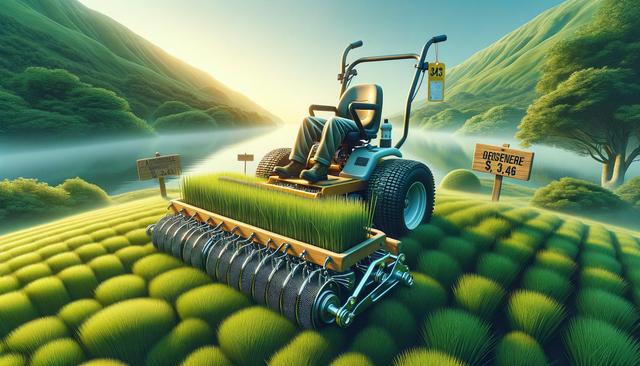Why Aeration Is Essential for Lawn Health
Lawn aeration is a critical part of maintaining a lush, green yard. Over time, soil becomes compacted, especially in high-traffic areas. This compaction prevents water, oxygen, and nutrients from reaching the grassroots, leading to weak growth and patchy grass. Aerating your lawn helps loosen the soil, improving drainage and promoting deeper root development. It’s particularly beneficial during the growing seasons of spring and fall when grass can recover quickly and take full advantage of enhanced soil conditions.
For many homeowners, purchasing an aerator can be a costly investment, especially for a tool that’s used only once or twice a year. Renting provides a more budget-friendly alternative while still delivering the benefits of proper lawn care. Additionally, rental units are typically maintained by professionals, ensuring that you get a machine that operates efficiently and safely.
Types of Aerators Available for Rent
When considering aerator rentals, it’s important to understand the different types available. The most common options include:
- Spike Aerators: These use solid tines to poke holes in the ground. While affordable, they may not be as effective in heavily compacted soil.
- Plug/Core Aerators: These remove small plugs of soil and are ideal for relieving compaction and promoting stronger root growth.
- Manual Aerators: Best for small lawns or spot treatments, they are lightweight and easy to use but require more physical effort.
- Tow-Behind Aerators: Designed for larger properties, these attach to lawn tractors and cover more ground efficiently.
Each type serves a different purpose, and rental centers usually offer guidance to help you choose the right one based on your lawn size and condition. Plug aerators are often recommended for their deep-penetrating action and long-lasting effects.
How to Find Budget-Friendly Aerator Rentals
Affordable aerator rentals can be found through local hardware stores, garden centers, and equipment rental businesses. To get the most value, consider these tips:
- Compare prices from different rental providers in your area.
- Look for weekday or half-day rental rates, which are often cheaper than weekend or full-day rates.
- Check for seasonal promotions during peak lawn care times like spring and fall.
- Ask about delivery options if you lack a vehicle capable of transporting the equipment.
Some rental companies even offer loyalty programs or discounts for repeat customers. Planning ahead and reserving your equipment early can also help secure the most affordable rates, especially during busy seasons.
Using a Rented Aerator Safely and Effectively
Once you’ve secured an aerator rental, it’s important to use it properly to avoid damage to your lawn or the machine. Here are a few safety and usage tips:
- Water your lawn the day before to soften the soil, making aeration easier.
- Mark sprinkler heads and underground utilities to prevent accidental damage.
- Make multiple passes in different directions for even coverage.
- Clean the equipment before returning it to avoid additional fees.
Most rental providers will give you a quick demonstration or provide instructions, but it never hurts to watch a tutorial online beforehand. Proper handling ensures you get the maximum benefit from the aeration process while preserving your lawn’s condition.
Additional Lawn Care Tips After Aeration
After aerating your lawn, taking a few extra steps can enhance the results and support healthier grass growth. Here are some recommended post-aeration practices:
- Overseed your lawn to fill in bare patches and improve turf density.
- Apply a balanced fertilizer to provide nutrients that encourage root growth.
- Water thoroughly to help seeds and nutrients settle into the soil.
- Avoid heavy foot traffic for a few weeks to allow roots to establish.
These steps help maximize the benefits of aeration, especially when done during the growing season. Regular aeration, combined with thoughtful lawn care, can transform your yard into a vibrant outdoor space without the need for expensive equipment purchases.








